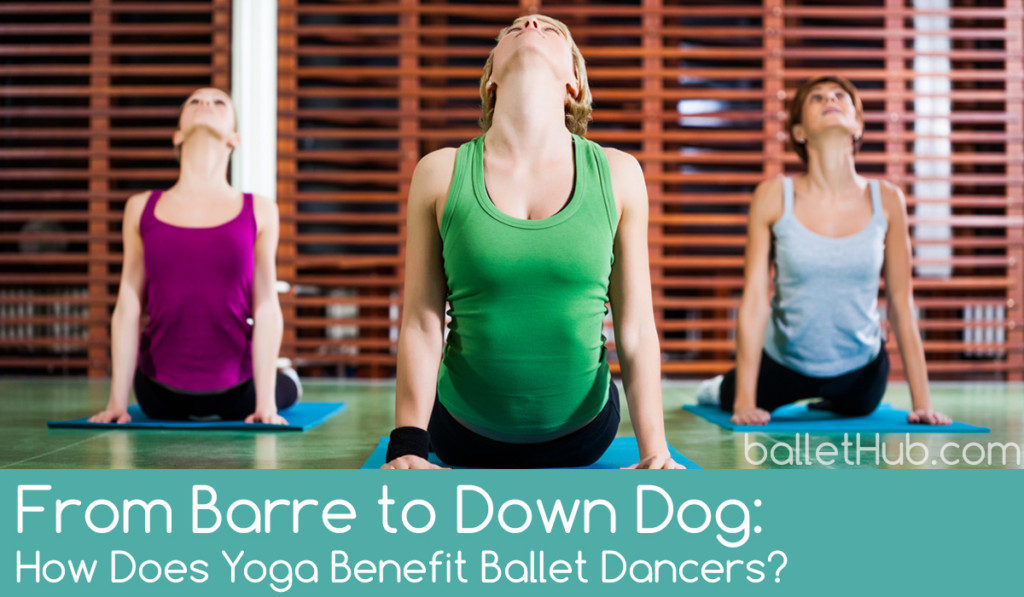In a world of arabesques and pirouettes, where do Downward Facing Dogs fit in? While Sun Salutations may not have a place at the barre, with cross-training and questions surrounding it remaining a hot topic in the ballet world, yoga can benefit dancers in a multitude of ways. Pilates is usually touted as being the perfect addition to a dancer’s strenuous schedule, largely because of the core-strengthening prowess that comes from hitting the Pilates mat: It’s true that Pilates targets the core and improves pelvic and spinal alignment, thus allowing the arms and legs to move freely, in addition to releasing tension that can plant itself in the lower back.
Meanwhile, yoga is sometimes left out of the cross-training conversation, mostly because one of the most commonly emphasized benefits of yoga is flexibility—something ballet dancers have in spades. So if they’re not looking to increase flexibility, why should dancers incorporate yoga into their cross-training, or should they?
When you link breath to movement, simply put, moving becomes easier.
First, it is necessary to point out that ballet and yoga share a few crucial similarities: In some way, they are both rooted in elongating and aligning the body, with symmetry, balance, and strength finding homes both on the mat and in the wings. Especially if you’re on a break or in an off-season, yoga can help dancers maintain their flexibility and balance, keeping the body open and muscles engaged. Many of yoga’s traditional standing poses, like Standing Bow/Standing Dancer, or Standing Head to Knee, target muscles that are used for developpes, while the upper arm strength gained from Downward Dog and Plank are beneficial for partnering. Of course, sometimes even the greatest dancers have tight spots, which yoga can unwind to improve overall range of motion.
Sounds good, right? Despite the magic that happens through the few things ballet and yoga have in common, do the biggest perks of yoga come from elements that aren’t just physical? Yoga’s greatest benefits are mental ones—meaning that it is a way of cross-training that keeps your body physically engaged and your mind at rest, a fascinating, invigorating combination for dancers. Simply put, yoga isn’t just a way of keeping extensions high and your core tight: Yoga creates freedom in the body. It allows you to check in with yourself mentally and physically, and follow how you feel rather than catering to a specific technique—which, in turn, can help your dancing.
When deciding whether to incorporate yoga into your cross-training, here are just a few of the significant ways it can change the mind-body relationship and help everything from your fouettes to your self-esteem outside the studio:
Channel the Power of Breathing
When most people think of yoga breathing, they picture things like alternate nostril breathing, which some find soothing. But really, to capture the power of your breath, all you need is a nice, deep inhale/exhale: Inhale up through your nose, exhale out through your mouth. There is no denying that ballet dancers, whether you’re dancing professionally or are training, have stressful jobs, and encounter high-pressure situations on an almost-daily basis. What is discussed less often are the negative benefits stress has on the body: Not only can high stress lead to anxiety and depression, a “stress response” also suppresses the immune system, making you more likely to catch a nasty virus that will make rehearsal unbearable. An easy way to combat this? Evoking a “relaxation response” to stress, or, as Harvard Health Publications put it, “deep breathing.” According to Harvard researchers, “breath focus helps you concentrate on slow, deep breathing and aids you in disengaging from distracting thoughts and sensations.” It releases tension, relaxes the mind as well as the body, and can even help reduce pain—all things that dancers could absolutely benefit from.
[Yoga] makes you stronger, smarter, and calmer, which lets you focus your energy and effort where it matters: On dancing.
Meanwhile, the benefits of breathing aren’t just mental: When you link breath to movement, simply put, moving becomes easier. It allows you to harness your energy, and do more with less effort (yes, it’s possible!). Long adagio sequence? Inhale as your leg makes its way to passé, exhale as you extend out (which also helps engage your core, as an added bonus). Develop this pattern, and see how your breath transforms what happens with your body.
Find Your Peace of Mind
Ballet is driven by the pursuit of perfection—something we know doesn’t exist, but strive for anyway, with hours spent toiling away in the studio, disciplined and focused on the purity of detail. When you find the right teacher or style, yoga is precisely the opposite: It’s about moving as you are, following how your body feels rather than forcing it to conform to a technique. Good technique is crucial to any professional or aspiring dancer, but can accepting your body, your personhood, and even your “flaws” help you reach new technical heights?
Yes. Yoga teaches you to tune out the self-critic, which gives you a refreshed sense of clarity to look at yourself honestly, rather than bashing yourself unnecessarily. When we let go of expectations, we open ourselves up to possibilities, and often, that’s when you surprise yourself, like playing around with pirouettes in the hallway and whipping out a flawless triple (that no one ever seems to see, right?). Unlike ballet, there’s no emphasis on competition, which means that it gives you an outlet to exist as you are. The result? You’re a more confident dancer.
Boosts Health Habits
Dancers are usually health-conscious people—their careers and training demand it! But yoga is a gentle reminder to do what feels good: Some days, that may mean standing on your hands; other days, your body may be begging for Child’s Pose. When you’re conscious of your body, what it feels, not just what it has to do, you become healthier. You crave foods that create energy and stamina, you learn to rest when your body feels tired, and you learn to check in with yourself: Dancers are often people-pleasers by nature, so learning to develop a healthy practice of self-love (even just stopping to ask “what does my body feel like doing? What do I need?”) can change the game. It makes you stronger, smarter (yoga improves memory, reaction time, and coordination), and calmer, which lets you focus your energy and effort where it matters: On dancing.
Need to get started? Here are a few incredible yoga poses for dancers:
- Pigeon pose (opening those hips, developing turnout).
- Psoas stretch (create space in the front of the hip, opening throughout the quad and back)
- Bridge pose (strengthen and realign your spine)
- Child’s pose (great place to release your back, and get that deep breath going)
- Sun Salutation flow

